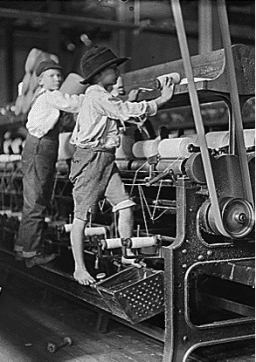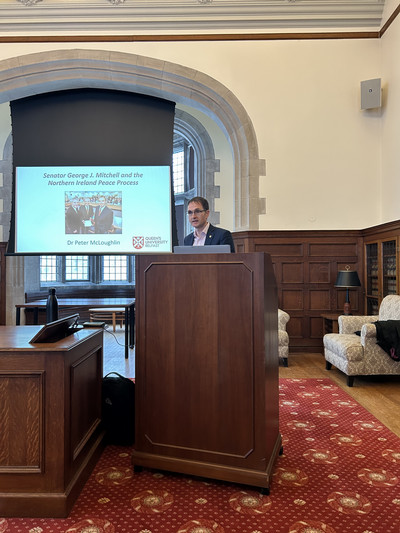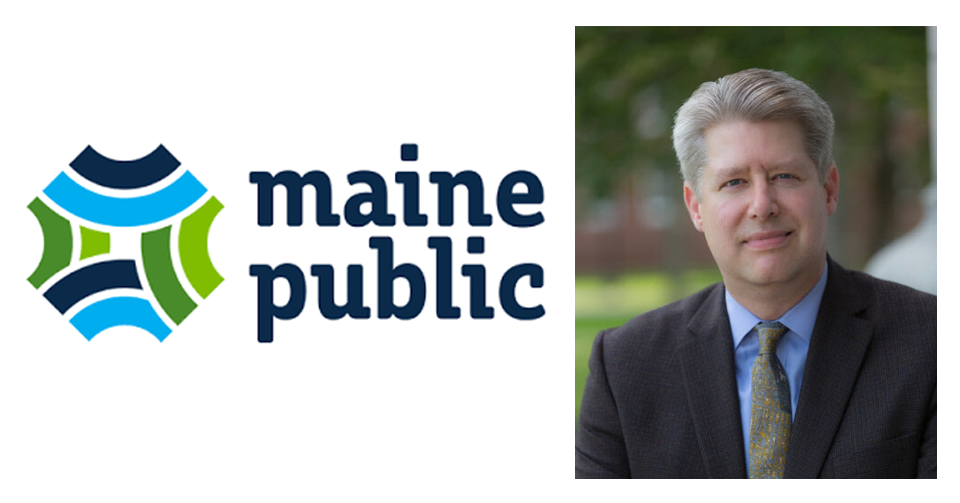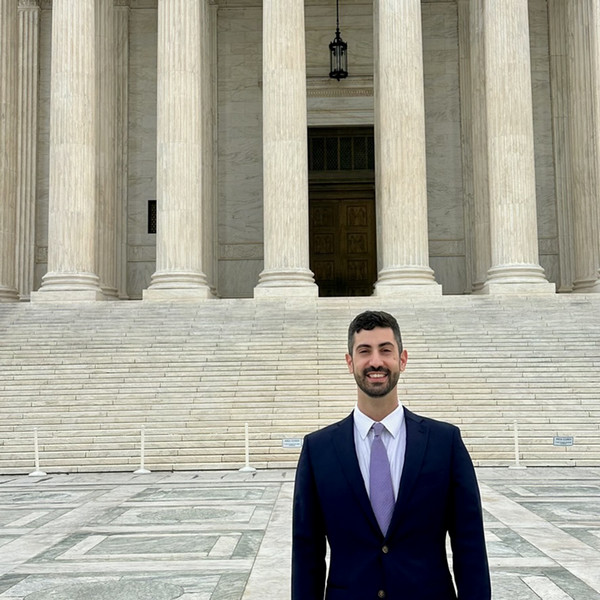Angus King: Capitalism and Its Discontents—The Case for Rules
Angus King H’07, a distinguished lecturer at the College since 2004, is a regular contributor to the Bowdoin Daily Sun. In his latest post, the former two-term governor of Maine warns that an unrestrained market can take America to a place it’s been before.

Capitalism (n.): An economic system characterized by private or corporate ownership of capital goods, by investments that are determined by private decision, and by prices, production, and the distribution of goods that are determined mainly by competition in a free market. (Merriam Webster)
I am a thoroughgoing capitalist. Twenty years ago, I had an idea, risked everything, sweated through some very long nights, and created a business that ultimately paid off—and I was handsomely rewarded. Without at least the possibility of that reward, I wouldn’t have taken the risk, created the jobs, helped my customers or generated millions of dollars of economic activity in Maine at a period when new economic activity was pretty scarce. This is by way of saying that I believe that free-market capitalism is the best system yet devised to produce widespread economic opportunity.

This belief is strengthened by having seen first-hand the results of the opposite system—state socialism as practiced in the old Soviet Union. Like many others just graduating from college, a buddy and I decided to take a trip to Europe after graduation (in 1966!), but our destination was a little different that most. After meeting up in West Germany and buying a fifteen-year-old German army surplus BMW motorcycle (my friend was on an early Honda), we headed east and spent the rest of the summer in Czechoslovakia, Hungary, and Yugoslavia. It was an amazing experience in many ways. We went places where people had never seen an American (let alone a Honda), met some wonderful every-day people, and saw an economic system very different from ours, up close and personal. And it (the economic system, not the people) was awful.
I have many vivid memories from those days—empty store windows, grocery stores (more like our little country general stores) with half empty shelves, more motorcycles than cars (because cars were beyond the reach of most workers), the presence of the military everywhere, unpainted rows and rows of drab public housing, no lights at night, fields being plowed with horses and oxen, police with machine guns instead of billy clubs, and not many smiles.
But I think one of my most poignant recollections is of a dinner with three East German medical students we had met at a camping area on the river in Prague. At the end of the night, after a pretty good quantity of beer (which helps with the language skills, to a point), they asked where we were headed. “Around Eastern Europe,” we replied, “then on to Paris and London and home.” Silence. Then a sad admission that they weren’t allowed to travel outside of the Soviet Bloc because of the government’s fear that they wouldn’t come back.
And we all agreed that any political system that has to lock its own people in was pretty lousy.
So capitalism is good and state socialism is bad. But “good” is not synonymous with “perfect.” The key phrase in the dictionary definition of capitalism above is “…prices, production, and the distribution of goods…are determined mainly by competition in a free market.” The first thing to observe is that “competition in a free market” is a decision-making system, not a flesh and blood person; the market, more than any individual, largely decides how much things will cost and what people will earn who make them. The second point is that “competition in a free market” is focused almost entirely on two things: quality and price; not much else counts.
“…capitalism is good and state socialism is bad. But “good” is not synonymous with “perfect.””
The result is that capitalism is really good at producing (mostly) decent products at (mostly) low prices. But the inner dynamic—the absolute essence of the system—is always toward lower input costs, and “input costs” is a fancy way of saying what the guy running the drill press gets to take home or what it costs to get rid of the waste from the plant. The great textile mills of Maine and New England didn’t go south 60 years ago for the weather; they went for cheaper labor. And they didn’t go from there to Mexico and Asia for the spicy food; they went for cheaper labor. And when the mills were here, in the early years of the last century, they didn’t employ kids and women 12 hours a day, six days a week because the jobs required short workers; they went for cheaper labor.
By the same token, the mills didn’t dump their poisonous waste into the rivers because they disliked fish; it was just much cheaper to dump the stuff through a straight pipe than to clean it up.
If a company (or its owners) decided to buck this logic and pay its workers more, or spend money on controlling pollution, or not employ child labor, the market generally was not very sympathetic. If those expenditures made its prices higher, its less benevolent competitors would promptly put it out of business.
This is what Marx and the other leftist intellectuals of the 19th Century argued—that the exploitation of workers and resources is hard-wired into the logic of the capitalist system itself and is not the product of cruel and heartless people at the top (although there were certainly plenty of those). If it were the latter, elevating better people up the corporate ladder would be the solution rather than attacking the system itself.
The problem is that we now know from experience that their alternative—state socialism—had it’s own set of hard-wired problems, starting with the lack of reward for creativity and efficiency that led in turn to the failures of the system so evident to me and my friend on that trip through Eastern Europe. It was pretty obvious that our system delivered the goods; theirs didn’t.
“Capitalism with rules…had the effect of shaving off the rough edges of an undeniably productive system and in the process saved us from most of the social and political unrest that engulfed much of the rest of the world in the first half of the 20th Century.”
So is this the either/or choice? One system inevitably tilted toward low wages, harsh working conditions, and intractable pollution, and the other toward shortages, low wages, and (interestingly) also intractable pollution? Fortunately, more by pragmatic trial and error than by adherence to a particular ideology, we evolved a third way: capitalism with rules, like minimum wage and child labor laws, protections for organized labor, and environmental protection. The market dictated none of these; to the contrary, the public—through the government—put them in place precisely because the market wouldn’t. And it worked. These rules had the effect of shaving off the rough edges of an undeniably productive system and in the process saved us from most of the social and political unrest that engulfed much of the rest of the world in the first half of the 20th Century.
We don’t have to speculate or make up horror stories about the defects of either system. All we have to do is look at history. In the Soviet Union and China we could see the misery and degradation endemic to their system, and many of us have first-hand memories of what it looked like. The excesses of unregulated capitalism here at home showed themselves a little longer ago, however, and memories seem to have dimmed. Children working in (literal) sweatshops, education ending at the 8th grade, thousands killed or maimed on the job, hopeless poverty, 70 hour work weeks, gross disparities between rich and poor, rampant stock manipulation and fraud, poisoned air and water, and early death paints the unpleasant picture of unrestrained capitalism in this country barely a hundred years ago.
Again, capitalism didn’t cure any of these problems itself; actually, it fought each reform in turn, usually by arguing intolerable costs or a drag on competitiveness. A perfect example is the reaction to new fire regulations put in place (by the government) after the terrible Triangle Shirtwaist fire, which occurred exactly 100 years ago in New York City. Harold Myerson, writing in a recent edition of TheWashington Post, captured the essence:
Businesses reacted as if the revolution had arrived. The changes to the fire code, said a spokesman for the Associated Industries of New York, would lead to “the wiping out of industry in this state.” The regulations, wrote George Olvany, special counsel to the Real Estate Board of New York City, would force expenditures on precautions that were “absolutely needless and useless.”
“The best government is the least possible government,” said Laurence McGuire, president of the Real Estate Board. “To my mind, this [the post-Triangle regulations] is all wrong.”
Does any of this sound familiar?
The fact is that the cures always came from an outside force—usually the government but occasionally organized labor, which imposed change through regulation or negotiation. Child labor laws, minimum wage and hour laws, occupational safety, clean air and water rules, securities laws, and compulsory education together wove a web which allowed capitalism to function (actually flourish) but protected it (and us) from its excesses.
Of course, reasonable people can differ about the appropriate level of regulation—where crucial protections end and frivolous over-regulation begins—but making these decisions is what politics is all about. There is no doubt that excessive regulation really can add unnecessary costs and impede competitiveness (especially in a globalized economy), so every new restriction—and some old ones—must be weighed in terms of both their costs as well as their benefits.
“…if there are no national standards, the competition between the states will inevitably engender a race to the bottom.”
But today we seem to be in a moment where the need for any regulation is in question and the market has been elevated to mythic status as the ultimate arbiter of all economic (and implicitly, social and cultural) decisions. And this isn’t all; the apostles of unregulated markets want to go beyond just getting rid of those pesky rules, they want to dismantle or at least neuter the institutions which make the rules, the only institutions with the power to provide counter-weights to the not-so-positive impulses of the market.
In other words, we’re being asked not just to roll back certain regulations but the idea of regulation itself—and to eviscerate the only entities we have that are realistically capable of doing the regulating. In the immortal words of conservative theoretician Grover Norquist: “I don’t want to abolish government. I simply want to reduce it to the size where I can drag it into the bathroom and drown it in the bathtub.”
A variation on this theme is the argument that well, regulation is okay, but it should only be on the state and local level—that things like minimum wage and environmental laws (and Social Security and Medicare, for that matter) are beyond the constitutional authority of Congress. The problem with this idea is that if there are no national standards, the competition between the states will inevitably engender a race to the bottom. Each state will try to outdo its neighbors in being “business-friendly,” which will be defined by the lowest minimum wage, the weakest environmental policy, or the most restrictions on unions—all in the name of attracting or retaining jobs. Companies will play states off against one another in these areas just as they do now in the areas of taxes and subsidies. Having lived this kind of competition for eight years, I haven’t the slightest doubt about this result.
I know that governments and unions can sometimes go too far—whether with over-burdensome regulations or outdated work rules or confiscatory taxes—but the solution ought to be to recognize and rein in the excesses, not throw out the whole idea of regulation and collective bargaining as many now seem to be urging. For if we do, if the unions are eviscerated and government is rendered impotent, we will have no defense left; the same unrestrained market forces that put our forebears to work in those mills at age 12 will be fully ascendant, and America will be a very different place than the one we have known for the century just past.
If you disagree, let me know which of your kids you’d like to see in the picture at the top.



